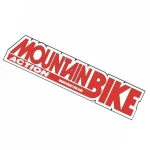AMERICAN CLASSIC VULCANITE TIRE REVIEW – AFFORDABLE ENDURO PERFORMANCE
Value and performance can go hand in hand.

AMERICAN CLASSIC VULCANITE TIRE REVIEW – AFFORDABLE ENDURO PERFORMANCE
American Classic has a legacy that has carried on for 40 years, beginning with founder Bill Shook, who was at the time a U.S. National Team road bike racer. His humble garage-built vision was to create lighter bicycle components, starting with just a few designs. Eventually, production moved overseas with the priority of making high-end aftermarket wheels. Now, coming back to the present day, American Classic is dedicated to making leaps in the bicycle tire industry with a range of tires spanning the world of commuter bikes, road bikes, gravel bikes and, of course, mountain bikes.
Tech info:
This tire gets its name straight out of a Star Trek/Superman mashup. It’s called the Vulcanite. American Classic classifies this as either an enduro or trail tire with different casings to differentiate between the two. We’ve tested the enduro-cased version, which features two flat-preventing 120-tpi layers with a soft-mixture, triple-compound tread on top that supposedly helps with trail damping and traction. This whole setup is tubeless-ready, of course, as if we even need to say that these days.
We tested the 29×2.5-inch version of the Vulcanite, but it also comes in 27.5×2.5 inches in all configurations. There is little price difference between the trail and enduro varieties, as both will set you back around $50 per unit. If you’ve found yourself out of luck due to a nail or extra-sharp stick, American Classic’s Road Hazard Replacement Program will get you 50 percent off a new tire. A limited two-year warranty is also offered to original owners in case of manufacturing defects.

Field test results:
We had issues right off the bat mounting our Vulcanite tires with anything but a persistent blast from an air compressor, but we had better luck mounting them to other rims with just a floor pump afterwards. Even having our pressure as low as 22 psi in the front and 25 psi in the rear didn’t concern us as we mashed sharp rocks and railed corners on the hardtail we chose to test these tires on. Immediately upon mounting the bike for the first time, we noticed the similarities between the Vulcanite and our editor’s favorite Maxxis Assegai. There is an uncanny resemblance in the way they look when on the bike, and the tread pattern is very similar but not quite the same.
Road climbs are slow ones where we could feel the tires grabbing into the asphalt with every stroke of our pedals. The effect isn’t as bad as with Maxxis’ MaxxGrip compound on the Assegai, but with the triple-compound tread, which is American Classic’s softer rubber compound, the rolling resistance was relatively high. This quality came in handy once we got off the road and began climbing on dry, loose soil, as the tread had no problem digging in, even under heavy torque.

Going downhill is where these tires really shine. After a couple of rides to loosen up the rubber and get the knobs gripping properly, we experienced no traction limits. We hate to keep bringing it up, but they really reminded us of the Assegai a lot. Compared directly to the Maxxis, the Vulcanite feels most at home on loose soil where it can dig in and grip hard. We managed to find a little bit of mud during our test of these tires and are happy to report they shed mud fairly well. Clogged knobs aren’t on the short list of misses with these tires, though every tire has its limits.
The biggest benefit from riding these tires was the level of confidence we had approaching particularly sketchy corners. We knew we could lean into them and the tires would grab. There is a level of predictability with them, even when you do start to slide, though we didn’t find it happening often. It made it easier to focus on the trail and our breaking points, knowing we could trust the tires.
We would readily change out our Assegais for a set of Vulcanites on our bike-park setups. These tires are undoubtedly made for enduro-style tracks with steep, loose, blown-out corners and epic rock gardens. That said, we’d feel confident putting one on the front of our trail bike and pairing it with a faster-rolling, less aggressive rear tire. It’s best to balance out tires like this in that way.
All in all, we did like these tires and would gladly throw a set on our personal bikes for the money-saving and performance qualities they provide. So far, they’ve held up quite well to some demanding terrain at low pressure. They may be slow-rolling and a tad bit heavy, but what enduro-designed tire isn’t these days? They got us up and down the hills just fine without a worry, so peace of mind wins.
HITS:
• Durable
• Grips well on loose surfaces
• Predictable
• Well priced
MISSES:
• A little heavy
• Slow-rolling
• Can be hard to mount
STAR RATING:★★★★½
Weight: 1,235 grams (29×2.5”, Enduro)
Price: $48-50
Contact: www.amclassic.com




